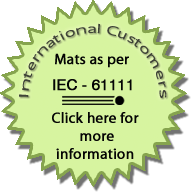
Minimum Critical Tests that Every Mat should pass
The following properties and analysis is provided by our technical experts and is based on the test methods adopted as per Indian Standard IS 15652:2006( Insulating mats mats for Electrical Purposes.)
This Standard is very stringent, as compared to IEC 61111 Standards, but it provides for high safety & long service life of the product.
As a user you will observe that the Critical tests are identified with the above twin purposes of high safety & long service life.
Electrical Properties
A. INSULATION RESISTANCE
First & foremost the Insulation Resistance (IR) of the mat (checked with a 5000 V Meggar) should be 100000 MΏ. A simple way would be to dip the mat in water for 24 hours at room tem. Subsequently the IR is checked on a sample piece of size 150 MM x 150 MM with the help of two electrodes i.e 25 MM diameter and 75 MM diameter, after one minute of application of the voltage. If the mat crosses the above IR the mat can be said to possess a highly insulated property providing high safety anyone operating and handling equipment in Switchgear and Control Rooms.
B. AC PROOF VOLTAGE
| Class | Thickness | AC Proof Voltage Kv |
| A up to 3.3 Kv | 2.0 MM | 10Kv |
| B 3.3 Kv to 11 Kv | 2.5 MM | 22 |
| C 11 Kv to 33 Kv | 3.0 MM | 36 |
A sample piece of the Insulating material of size 1270 x 1270 MM of the relevant thickness may be drawn as per the above table. The test equipment for the AC proof test should have an opening of 762 x 762 MM at its center. A sponge is put into this cavity to fill up this cavity completely and further soaked with a conductive liquid material i.e Water. The sample of the mat is placed on this opening above the wet sponge and further a grounded metal plate is placed on top of the mat. The wet sponge under the mat and the grounded metal plate above the mat are electrodes. The pad is then energized with a test voltage as per the table above. The test is successful if the specified voltage is reached.
(a) For type test, the test is conducted for 3 minutes.
(b) For routine test, the test is conducted for 1 minute.
If the mats pass the above AC Proof Voltage test for the above time periods, then it is clear that the insulating mat meets the safety requirements required to prevent any burn injury or even death in some cases due to high voltage.
While the test is being conducted flashover can be seen, which indicates that the current is not being conducted by the mat.
C. LEAKAGE CURRENT
Leakage Current of the insulated mat can also be measured while performing the AC Proof Voltage Test. The allowable limit for this is 10 mA. Electromat Insulated mats achieve a low leakage of 0.7 mA which is near negligible.
D. Thermal Properties
i] Flame Retardance
A test piece of size 150 MM x150 MM is placed above a flame of 20 + 2 MM blue flame from a nozzle of diameter 9.5mm for 10 seconds to cause a fire on the mat and then withdrawn. The Fire should extinguish within 5 seconds. In case of Electromat, the fire extinguishes in less than two seconds
Further restricting the flame to ten seconds is also not in line with real life situations and therefore tests are carried out till it starts burning and then withdrawn. In this case also the same result of fire extinguishing is less than two seconds is achieved. Further the mats, if desired can be produced with LOW SMOKE and LOW OXYGEN INDEX parameters if so specified by the client.
ii] Effect of Acids, Alkalis, Diesel and Transformer Oil
In real life situations the Safety mats can be exposed to all sorts of Acids, Alkalies, Oils and Diesel etc that are normally present in any Industrial Set Up or Utility. Normally exposure to such liquids leads to a fast detoriation of the physical properties of a mat (read Rubber Mats) resulting in the product breaking / disintegrating into smaller pieces, thereby forcing the user to either throw it away or replace it. In either case the user does not get the required value from the product apart from it posing a safety risk.
The test on the above liquids are carried out by immersion of the test piece in each medium/liquid (30 percent concentrated acid, 30 percent concentrated alkalis, diesel and Transformer oil for 48 hours) at room temperature. After conditioning the test piece is dried for 4 hours at room temperature and the Tensile and Elongation is checked. The values of elongation and tensile should not change more than 20%. This particular test is very critical in ensuring the quality of your prurchase.
iii] Extreme low temperature
For countries with low temperatures, The mats can be produced to perform at upto -40 Degrees centigrade or - 104 degrees Fahrenheit.
The test is deemed successful if no tear break or crack is visible.
As a user, it is advised that you must insist on conducting the above tests either at your own Quality Control Lab or at an outside agency like ERDA- Baroda, India or at the CPRI Test Lab at Noida, UP, because this relates to safety of workmen and a compromise on this aspect can have a direct consequence on the life and safety of your workers. Apart from the safety, you can be sure that a product which does not meet these critical parameters will not last the required/projected service life thereby increasing your cost.









